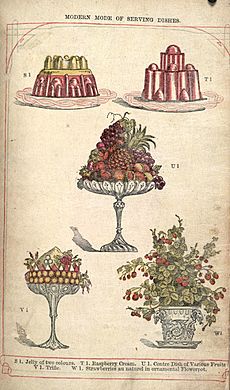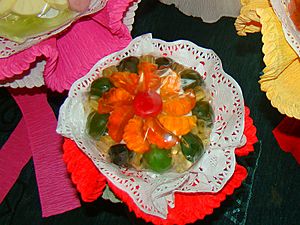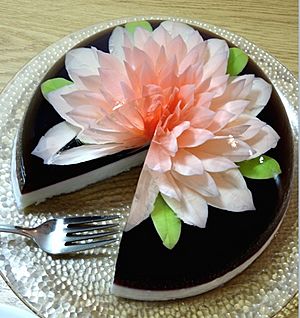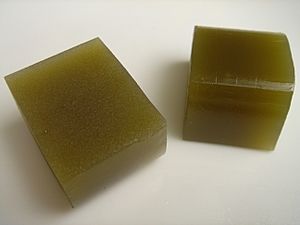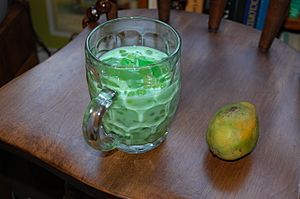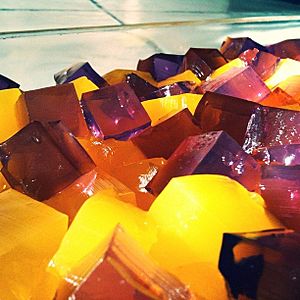Gelatin dessert facts for kids
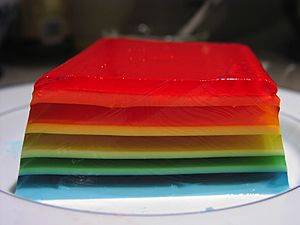
A multicoloured layered gelatin-based dessert
|
|
| Type | Dessert |
|---|---|
| Serving temperature | Chilled |
| Main ingredients | Gelatin |
Gelatin desserts, often called Jelly or Jello, are sweet treats made from a special ingredient called gelatin. Gelatin comes from a natural protein found in animals, and it helps these desserts become wobbly and jiggly!
People have been enjoying these desserts for a long time. The first time we see "jelly" mentioned as a dessert was in the 1700s by a cook named Hannah Glasse. It was even part of a fancy dessert called a trifle. Later, in the 1800s, famous English cookbook writers like Eliza Acton and Isabella Beeton also shared recipes for jelly.
You can make gelatin desserts from scratch using plain gelatin, or you can buy mixes that already have flavors and other ingredients added. You can also find them ready-made in stores, from big fancy shapes to small cups. Some popular brands of gelatin mixes include Aeroplane Jelly in Australia, Hartley's in the UK, and Jell-O in North America.
Contents
A Look Back: The History of Gelatin Desserts

Before gelatin became easy to buy in stores, people used to make a dessert called "calf's foot jelly." As the name suggests, they got the gelatin from the feet of calves! This gelatin was used in both savory dishes (like meat jellies called aspic) and sweet desserts mixed with fruit juice and sugar.
In the 1700s, cooks would color these jellies with natural dyes. For example, they used violet juice for blue, saffron for yellow, and spinach for green. They would layer these colors in glasses and flavor them with sugar, lemon juice, and spices. This was called jelly. Hannah Glasse was the first to write about using this jelly in a trifle dessert in her cookbook from 1747.
Making gelatin from animal bones took a lot of time and effort. Because of this, having gelatin desserts was a sign of wealth until the mid-1800s. It meant you had a big kitchen staff to do all the work!
How Gelatin Desserts Are Made
To make a gelatin dessert, you first dissolve gelatin in hot liquid. This liquid usually has flavors and other ingredients like sugar, fruit juice, or sugar substitutes. You can add these ingredients yourself, or use a pre-made mix that just needs hot water.
Most store-bought gelatin mixes contain flavors, adipic acid, fumaric acid, sodium citrate, and food colors. Even though gelatin comes from animals, it's processed so much that the US government doesn't classify the final product as a meat product.
Commercial gelatin mixes come as a powder or a solid block. You mix either with hot water until it completely dissolves. Then, you add cold water to reach the right amount of liquid.
A trick to help powdered gelatin dissolve better is to sprinkle it over the liquid a few minutes before heating. This is called "blooming" the gelatin. After everything is dissolved, you put the mixture in the fridge. As it cools, it slowly turns into a wobbly gel.
You can make gelatin desserts extra special! Try using fancy molds, creating colorful layers by pouring new, slightly cooled liquid over a set layer, or adding things like marshmallows or fruit. Just be careful with some fresh fruits, as they can stop the gelatin from setting (more on that below!).

When fully chilled, most gelatin desserts have a texture like custard. They hold their shape well when cold but melt into a liquid when warm. If you add extra gelatin, you can make a rubbery product that can be cut into shapes, like "Knox Blox." Even higher amounts of gelatin are used to make gummy candies that stay solid at room temperature.
Gelatin Art Desserts
Gelatin art desserts, also known as 3D gelatin desserts, are super cool! They are made by injecting colorful shapes into a clear gelatin base. This amazing technique started in Mexico and has become popular in many other countries.
To make these, you need high-quality gelatin that is very clear and doesn't have much smell or taste. The clear base is made with gelatin, water, sugar, and citric acid.
Once the clear gelatin base has set, colorful shapes are injected into it using a special syringe. The liquid injected usually contains a sweetener, an edible liquid like milk or cream, food coloring, and a thickener like starch or more gelatin.
The shapes are created by making tiny cuts in the clear gelatin base with sharp tools. Then, the colored liquid fills these cuts, making the shapes visible. Often, people use sterile medical needles or special gelatin art tools that cut and fill with color at the same time.
When combined with other ingredients like whipping cream or mousse, these gelatin art desserts can look like amazing cakes!
Other Ways to Make Jelly: Gelatin Substitutes
Sometimes, people use other ingredients instead of animal-based gelatin. These are often plant-based gelling agents, which are similar to pectin. They have slightly different properties, so they might need different ways of preparing or storing them. These substitutes are also great for people with certain dietary needs, like vegans or vegetarians.
- Agar: This gelling agent comes from red algae (a type of seaweed). It's very popular in many Asian desserts and is a common substitute for gelatin in quick jelly mixes. Agar needs a higher temperature to dissolve, but its gels set faster and stay solid at warmer temperatures (around 40°C or 104°F) compared to gelatin (which melts around 15°C or 59°F).
- Carrageenan: Another common seaweed-based substitute is carrageenan. It has been used in food for a very long time. The Philippines is a big producer of carrageenan. In the Philippines, carrageenan jelly is traditionally called gulaman. It's used in many desserts and sold as dried bars or powder. Unlike gelatin, gulaman sets at room temperature and can melt and then re-set when cooled again. It also sets more firmly than agar and doesn't have a strong smell when cooking. Carrageenan is often used in kosher and halal cooking, where animal gelatin might not be allowed.
- Konjac: This is another gelling agent used in many Asian foods, including popular konnyaku fruit jelly candies.
The Science Behind the Wobble: Chemistry of Gelatin
Gelatin is made from collagen, a protein found in animal parts like bones and skin. Collagen is like a tiny rope made of three twisted strands. To make gelatin dessert, you mix collagen with water and heat it up. This heat breaks the bonds that hold the three strands together. As the gelatin cools, these strands try to reform, but now tiny bubbles of liquid get trapped in between. This is what gives gelatin its wobbly, gel-like texture!
Gelatin is a special protein because it can act like both an acid and a base. This means it can react with different things, like sugars and other food additives. This makes gelatin very useful in many foods. It can help keep foams stable in marshmallows, prevent large ice crystals in ice cream, and even help mix oil and water in foods like toffee.
Even though fruit is often added to gelatin desserts, some fresh fruits contain special enzymes called proteases. These enzymes are like tiny scissors that cut up the gelatin molecules into pieces too small to form a firm gel. If you use these fresh fruits, your dessert might never "set" or become firm.
For example, fresh pineapple has an enzyme called bromelain. Kiwifruit has actinidin, figs have ficain, and papaya has papain. But don't worry! Cooking or canning these fruits destroys these enzymes. So, canned pineapple, for instance, works perfectly fine in a gelatin dessert!
Safety of Gelatin Desserts
You might have heard about "mad-cow disease" (BSE) which can come from eating tainted beef. However, there has never been a known case of BSE being passed on through collagen products like gelatin. So, gelatin desserts are considered safe to eat.
Jelly Around the World

Jelly-like desserts are enjoyed all over the world in many different forms:
- Aam papad: A mango preserve from India.
- Almond jelly: A sweet dessert from Hong Kong.
- Chakkavaratti: A jackfruit preserve from Southern India.
- Coffee jelly: A popular dessert in Japan.
- Jellied cranberry sauce: A holiday favorite in the U.S. and UK.
- Götterspeise: A German dessert made with gelatin.
- Grass jelly: A food from China and Southeast Asia, often served in drinks.
- Bocadillo: A Latin American candy made from guava and panela.
- Hitlerszalonna (meaning 'Hitler's bacon'): A dense fruit jam from Hungary, eaten during World War II when real bacon was scarce. It was made from mixed fruits like plum and sold in brick shapes.
- Konjac: A type of Japanese jelly.
- Jell-O: Was named the official snack food of the U.S. state of Utah in 2001!
- Mayhaw jelly: A special treat in parts of the American South.
- Muk: A type of Korean jelly, seasoned and eaten as a cold salad.
- Nata de coco: Jelly made from coconuts, originally from the Philippines.
- Turkish delight: A chewy, jelly-like Turkish dessert.
- Yōkan: A sweet, pasty jelly dessert from Japan, often made with beans or sweet potato.
See also
 In Spanish: Gelatina de postres para niños
In Spanish: Gelatina de postres para niños


